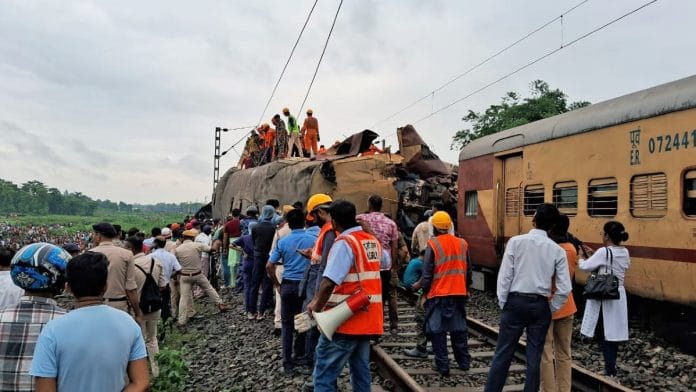Kolkata: At least eight passengers were killed and another 60 admitted to various hospitals with injuries after a goods train collided with Sealdah-bound Kanchenjunga Express in West Bengal’s Darjeeling district Monday morning. Among those who lost their lives in the collision were two loco pilots and the guard of the goods train.
The collision occurred near Rangapani, a few km from New Jalpaiguri, causing three rear compartments of the express train to derail. Visuals are coming to light of mangled remains of the three rear compartments of the express train, including the parcel van.
Jaya Varma Sinha, chairperson and CEO of the Railway Board, said in a press conference Monday that the “cargo train driver disregarded the signal and prima facie it seems human error was the likely cause of the accident”.
“Despite a signal to stop, the goods train continued to move. The driver has perished so we do not have evidence,” she said, adding that a detailed enquiry will be conducted but relief and rescue is the priority for now.
The Railway Board chairperson also clarified that the Indian Railways’ indigenous anti-collision system, popularly called ‘Kavach’, has not been installed along rail routes in West Bengal yet, “but it is planned”.
“Let me assure you safety is the priority of the Railway organisation and we are doing everything to ensure train operations remain safe. Kavach is important and we are working to proliferate it in mission mode,” she said.
Meanwhile, Union Railway Minister Ashwini Vaishnaw rushed to the accident spot Monday afternoon. After visiting the spot, Vaishnaw told the media that the rescue operation was completed speedily and Commission of Railway Safety was looking into the incident. “The enquiry under Commission of Railway Safety has commenced. The data points and data logs are being looked into. Our focus is on rescue and restoration,” he said.
Chief Minister Mamata Banerjee also reached Bagdogra airport to take stock of the situation, and Governor C.V. Ananda Bose is expected to arrive soon.
Passengers from Coach S6 of Kanchenjunga Express told reporters present at the spot that the express train was stationary when they felt the impact of the collision. They added that locals were the first to rush to their help, while it took the administration nearly an hour to reach the accident spot. Landslides triggered by incessant rainfall in districts of northern Bengal since the past one week have disrupted road access to parts of the region.
According to Railways officials, unaffected compartments of the express train were moved to nearby Malda district with the help of a diesel engine.
The Kanchenjunga Express runs on Sunday, Tuesday, Thursday and Friday from Agartala in Tripura to Sealdah station in Kolkata.
The collision brought back memories of the Coromandel triple train tragedy from exactly a year ago in Odisha’s Balasore district that claimed at least 275 passengers.
Also Read: Just 2% of India’s rail track covered by Kavach, tech that ‘could have prevented Odisha tragedy’
‘Passenger trains remain mobile mortuaries’
The Trinamool Congress (TMC) questioned the slow rollout of ‘Kavach’ in the aftermath of the collision. “The self-indulgent photo-ops for Vande Bharat train inaugurations have not aged well. Sadly, India’s passenger trains are still neglected and remain mobile mortuaries due to slow roll-out of anti-collision devices,” Rajya Sabha MP Derek O’Brien told ThePrint.
He added that in 2022, the Ministry of Railways had told the Rajya Sabha that “safety is accorded the highest priority”.
“The ministry used the term ‘rechristened’ basically admitting they pinched an idea from 2009 and were only packaging it differently. Of the total railway route of over one lakh km across the country, Kavach has been installed on only 1,465 km so far,” he said.
The anti-collision system ‘Kavach’ aims to prevent the train from passing the signal at Red — which indicates danger. It was developed by the Research Design and Standards Organisation (RDSO) in collaboration with three Indian firms.
Capable of relaying SOS messages, ‘Kavach’ can also activate the train’s brake systems if the loco pilot fails to control the speed of the train in an emergency.
Union Railway Minister Ashwini Vaishnaw had informed Rajya Sabha in February this year that ‘Kavach’ has been deployed along 1,465 km of rail tracks and 139 locomotives under South Central Railway. Tenders for the anti-collision system have been awarded for Delhi-Mumbai and Delhi-Howrah corridors — a route spanning approximately 3,000 km.
“Works for provision of Intrusion Detection System to prevent accidents involving elephants have been commissioned on 48 km route already identified vulnerable sections over Northeast Frontier Railway. Further, based on the vulnerability of the locations where elephant movements happen frequently over the tracks, works have also been sanctioned on the Indian Railway,” the minister had told Parliament.
Addressing the media Monday, the Railway Board Chairperson said ‘Kavach’ will be implemented along 3,000 km of rail route this year and along another 3,000 km next year.
“We are gradually building it up for the entire country, because those who supply the equipment need to ramp up production. We are working with them and persuading them to make it as fast as possible because the more we proliferate this system, the better it will be,” she said.
CM Mamata Banerjee while saying the Ministry of Railways has become “parentless” after the annual Railway budget was merged with the annual Union budget under the Modi government, highlighted the importance of ‘Kavach’.
“I introduced the anti-collision device when I was rail minister. I put Konkan Railway at work for this in Mumbai and Goa. I visited Madgaon where it was invented and it was implemented in the trains. If a driver dozes off, it sounds an alarm. If two trains come in close proximity it prevents collision. They can name it whatever they want but they need to protect passengers first,” she said.
(Edited by Amrtansh Arora)
Also Read: How govt’s budget transparency push is making this rail PSU switch tracks from its core business






